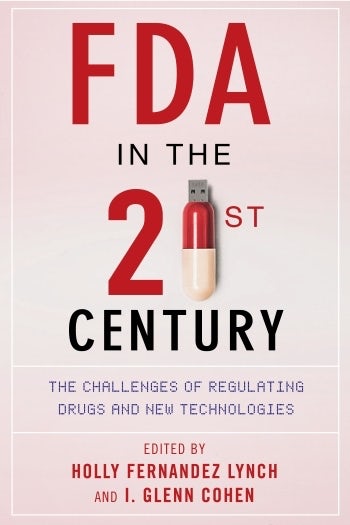In its decades-long effort to assure the safety, efficacy, and security of medicines and other products, the Food and Drug Administration has struggled with issues of funding, proper associations with industry, and the balance between consumer choice and consumer protection. Today, these challenges are compounded by the pressures of globalization, the introduction of novel technologies, and fast-evolving threats to public health. With essays by leading scholars and government and private-industry experts, FDA in the Twenty-First Century addresses perennial and new problems and the improvements the agency can make to better serve the public good.
The collection features essays on effective regulation in an era of globalization, consumer empowerment, and comparative effectiveness, as well as questions of data transparency, conflicts of interest, industry responsibility, and innovation policy, all with an emphasis on pharmaceuticals. The book also intervenes in the debate over off-label drug marketing and the proper role of the FDA before and after a drug goes on the market. Dealing honestly and thoroughly with the FDA's successes and failures, these essays rethink the structure, function, and future of the agency and the effect policy innovations may have on regulatory institutions abroad.
- Table of Contents
- Acknowledgments
- Introduction, by Holly Fernandez Lynch and I. Glenn Cohen
- 1. Historical Themes and Developments at FDA Over the Past Fifty Years, by Peter Barton Hutt
- Part 1. FDA in a Changing World
- Introduction, by Holly Fernandez Lynch
- 2. A Global and Innovative Regulatory Environment for the U.S. FDA, by Howard Sklamberg and Jennifer Devine
- 3. FDA and the Rise of the Empowered Patient, by Lewis A. Grossman
- 4. After the FDA: A Twentieth-Century Agency in a Postmodern World, by Theodore W. Ruger
- 5. The Future of Prospective Medicine Under the Food and Drug Administration Amendments Act of 2007, by Barbara J. Evans
- Part 2. Preserving Public Trust and Demanding Accountability
- Introduction, by Christopher Robertson
- 6. Global Trends Toward Transparency in Participant-Level Clinical Trials Data, by Alla Digilova, Rebecca Li, Mark Barnes, and Barbara Bierer
- 7. Conflicts of Interest in FDA Advisory Committees: The Paradox of Multiple Financial Ties, by Genevieve Pham-Kanter
- 8. The Crime of Being in Charge: Executive Culpability and Collateral Consequences, by Katrice Bridges Copeland
- 9. Recalibrating Enforcement in the Biomedical Industry: Deterrence and the Primacy of Protecting the Public Health, by Patrick O’Leary
- Part 3. Protecting the Public Within Constitutional Limits
- Introduction, by Glenn Cohen
- 10. Prospects for Regulation of Off-Label Drug Promotion in an Era of Expanding Commercial Speech Protection, by Aaron S. Kesselheim and Michelle M. Mello
- 11. The FDCA as the Test for Truth of Promotional Claims, by Christopher Robertson
- 12. Why FDA’s Ban on Off-Label Promotion Violates the First Amendment: A Study in the Values of Commercial Speech Protection, by Coleen Klasmeier and Martin H. Redish
- Part 4. Timing Is Everything: Balancing Access and Uncertainty
- Introduction, by W. Nicholson Price II
- 13. Speed Versus Safety in Drug Development, by R. Alta Charo
- 14. Overcoming “Premarket Syndrome”: Promoting Better Postmarket Surveillance in an Evolving Drug Development Context, by Shannon Gibson and Trudo Lemmens
- 15. FDA’s Public Health Imperative: An Increased Role for Active Postmarket Analysis, by Efthimios Parasidis
- Part 5. Old and New Issues in Drug Regulation
- Introduction, by Alta Charo
- 16. The Drug Efficacy Study and Its Manifold Legacies, by Daniel Carpenter, Jeremy Greene, and Susan Moffitt
- 17. Drug Safety Communication: The Evolving Environment, by Geoffrey Levitt
- 18. Innovation Policy Failures in the Manufacturing of Drugs, by W. Nicholson Price II
- Part 6. Regulatory Exclusivities and the Regulation of Generic Drugs and Biosimilars
- Introduction, by Benjamin N. Roin
- 19. From “Recycled Molecule” to Orphan Drug: Lessons from Makena, by Kate Greenwood
- 20. FDA, Negotiated Rule Making, and Generics: A Proposal, by Marie Boyd
- 21. The “Follow-On” Challenge: Statutory Exclusivities and Patent Dances, by Arti Rai
- 22. FDA Regulation of Biosimilars, by Henry Grabowski and Erika Lietzan
- Part 7. New Wine in Old Bottles: FDA’s Role in Regulating New Technologies
- Introduction, by Frances H. Miller
- 23. Analog Agency in a Digital World, by Nathan Cortez
- 24. Twenty-First-Century Technology with Twentieth-Century Baggage: FDA Regulation of Regenerative Medicine, by Margaret Foster Riley
- 25. Device-ive Maneuvers: FDA’s Risk Assessment of Bifurcated Direct-to-Consumer Genetic Testing, by Elizabeth R. Pike and Kayte Spector-Bagdady
- 26. A New Regulatory Function for E-Prescriptions: Linking FDA to Physicians and Patient Records, by Andrew English, David Rosenberg, and Huaou Yan
- 27. Race and the FDA, by Jonathan Kahn
- Contributors
- Index

